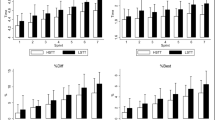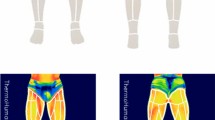Abstract
Purpose
To examine whether two consecutive soccer matches would affect skin temperature (t sk) measured via infrared thermography (IRT) in under-20 (U-20) soccer athletes, as well as verify whether the t sk changes would be different between regions of interest.
Methods
A cross sectional study. Ten under-20 soccer athletes [age 19.0 ± 1.0 years; height 181.3 ± 6.6 cm; body fat percentage (BF%) 9.0 ± 1.8%, body surface area 1.9 m2 and \(\dot{V}\)O2max 56.4 ± 3.2 ml min−1 kg−1]. Skin thermal responses obtained by IRT and creatine kinase concentration (CK) were evaluated in response to two soccer matches with 3 days of recovery between each match.
Results
The t sk increased (≅1.0 °C) 24 h after the first match in all studied regions of interest (ROIs), returning to near pre-match values 48 h after the first match. However, after playing the second match, the t sk increased even more (≅1.5 °C) 24 h after in all the considered ROIs, not returning to pre-match values 48 h after. Regarding CK analysis, its course during the experiment was similar to t sk, with high values 24 h after (first match 763.8 ± 294.5 U/L; second match 784.1 ± 298.8 U/L) and recovering 48 h after (first match 526.4 ± 289.7 U/L; second match 672.2 ± 285.0 U/L) both matches. However, when the two matches are compared, CK showed a higher value 48 h after the second match in comparison to first match (P = 0.002). The t sk and CK were moderately correlated in all ROIs analyzed, with higher correlation in the anterior right leg (r = 0.425) and anterior left leg (r = 0.428).
Conclusion
The t sk of lower limbs as well as CK markedly change in response to two consecutive matches separated by an interval of 3 days. There is indication of the highest inflammatory response after the second match, which was preceded by just a 3-day recovery. In addition, a general increase was obtained in thighs and legs in anterior and posterior views.


Similar content being viewed by others
References
Nedelec M, McCall A, Carling C, Legall F, Berthoin S, Dupont G (2012) Recovery in soccer: part I—post-match fatigue and time course of recovery. Sports Med 42(12):997–1015
Nédélec M, Halson S, Abaidia A-E, Ahmaidi S, Dupont G (2015) Stress, sleep and recovery in elite soccer: a critical review of the literature. Sports Med 45(10):1387–1400
Ascensão A, Rebelo A, Oliveira E, Marques F, Pereira L, Magalhães J (2008) Biochemical impact of a soccer match—analysis of oxidative stress and muscle damage markers throughout recovery. Clin Biochem 41(10):841–851
Ispirlidis I, Fatouros IG, Jamurtas AZ, Nikolaidis MG, Michailidis I, Douroudos I, Margonis K, Chatzinikolaou A, Kalistratos E, Katrabasas I (2008) Time-course of changes in inflammatory and performance responses following a soccer game. Clin J Sport Med 18(5):423–431
Fatouros IG, Chatzinikolaou A, Douroudos II, Nikolaidis MG, Kyparos A, Margonis K, Michailidis Y, Vantarakis A, Taxildaris K, Katrabasas I (2010) Time-course of changes in oxidative stress and antioxidant status responses following a soccer game. J Strength Cond Res 24(12):3278–3286
Mohr M, Draganidis D, Chatzinikolaou A, Barbero-Álvarez JC, Castagna C, Douroudos I, Avloniti A, Margeli A, Papassotiriou I, Flouris AD (2015) Muscle damage, inflammatory, immune and performance responses to three football games in 1 week in competitive male players. Eur J Appl Physiol 116:179–193
Dellal A, Lago-Peñas C, Rey E, Chamari K, Orhant E (2015) The effects of a congested fixture period on physical performance, technical activity and injury rate during matches in a professional soccer team. Br J Sports Med 49:390–394
Drew MK, Finch CF (2016) The relationship between training load and injury, illness and soreness: a systematic and literature review. Sports Med 46(6):861–883
Buchheit M (2014) Monitoring training status with HR measures: do all roads lead to Rome? Front Physiol 27:5–73
Silva JR, Rebelo A, Marques F, Pereira L, Seabra A, Ascensão A, Magalhães J (2013) Biochemical impact of soccer: an analysis of hormonal, muscle damage, and redox markers during the season. Appl Physiol Nutr Metab 39(4):432–438
Owen AL, Wong DP, Dunlop G, Groussard C, Kebsi W, Dellal A, Morgans R, Zouhal H (2016) High-intensity training and salivary immunoglobulin a responses in professional top-level soccer players: effect of training intensity. J Strength Cond Res 30(9):2460–2469
Gastin PB, Meyer D, Robinson D (2013) Perceptions of wellness to monitor adaptive responses to training and competition in elite Australian football. J Strength Cond Res 27(9):2518–2526
Hildebrandt C, Raschner C, Ammer K (2010) An overview of recent application of medical infrared thermography in sports medicine in Austria. Sensors 10(5):4700–4715
Ring EF, Ammer K (2012) Infrared thermal imaging in medicine. Physiol Meas 33(3):R33–R46
Moreira DG, Costello JT, Brito CJ, Adamczyk JG, Ammer K, Bach AJ, Costa CM, Eglin C, Fernandes AA, Fernández-Cuevas I, Ferreira JJ, Formenti D, Fournet D, Havenith G, Howell K, Jung A, Kenny G, Kolosovas-Machuca E, Maley MJ, Merla A, Pascoe DD, Priego Quesada JI, Schwartz R, Seixas A, Selfe J, Vainer B, Sillero Quintana M (2017) Thermographic imaging in sports and exercise medicine: a Delphi study and consensus statement on the measurement of human skin temperature. J Therm Biol 69:155–162
Pimenta EM, Coelho DB, Cruz IR, Morandi RF, Veneroso CE, de Azambuja Pussieldi G, Carvalho MRS, Silami-Garcia E, Fernández JADP (2012) The ACTN3 genotype in soccer players in response to acute eccentric training. Eur J Appl Physiol 112(4):1495–1503
Tidball JG, Villalta SA (2010) Regulatory interactions between muscle and the immune system during muscle regeneration. Am J Physiol Regul Integr Comp Physiol 298(5):R1173–R1187
Paulsen G, Mikkelsen UR, Raastad T, Peake JM (2012) Leucocytes, cytokines and satellite cells: what role do they play in muscle damage and regeneration following eccentric exercise. Exerc Immunol Rev 18(1):42–97
Page P (1995) Pathophysiology of acute exercise-induced muscular injury: clinical implications. J Athl Train 30(1):29–34
Silva YA, Santos BH, Andrade PR, Santos HH, Moreira DG, Sillero-Quintana M, Ferreira JJA (2017) Skin temperature changes after exercise and cold water immersion. Sport Sci Health 13(1):195–202
Al-Nakhli HH, Petrofsky JS, Laymon MS, Berk LS (2012) The use of thermal infra-red imaging to detect delayed onset muscle soreness. J Vis Exp 59:e3551
Bandeira F, Muniz de Moura MA, Abreu de Souza M, Nohama P, Borba Neves E (2012) Can thermography aid in the diagnosis of muscle injuries in soccer athletes? Rev Bras Med Esporte 18(4):234–239
Thorpe R, Sunderland C (2012) Muscle damage, endocrine, and immune marker response to a soccer match. J Strength Cond Res 26(10):2783–2790
Heisterberg MF, Fahrenkrug J, Krustrup P, Storskov A, Kjær M, Andersen JL (2013) Extensive monitoring through multiple blood samples in professional soccer players. J Strength Cond Res 27(5):1260–1271
Marfell-Jones M, Olds T, Stewart A, Carter L (2006) International standards for anthropometric assessment. The International Society for the Advancement of Kim Anthropometric (ISAK), Potchefstroom, South Africa
Jackson AS, Pollock ML (1978) Generalized equations for predicting body density of men. Br J Nutr 40(3):497–504
Du Bois D, Du Bois EF (1989) A formula to estimate the approximate surface area if height and weight be known. Nutrition 5(5):303–311
Bangsbo J, Iaia FM, Krustrup P (2008) The Yo-Yo intermittent recovery test. Sports Med 38(1):37–51
Castagna C, Impellizzeri FM, Chamari K, Carlomagno D, Rampinini E (2006) Aerobic fitness and yo-yo continuous and intermittent tests performances in soccer players: a correlation study. J Strength Cond Res 20(2):320–325
Tanaka H, Monahan KD, Seals DR (2001) Age-predicted maximal heart rate revisited. J Am Coll Cardiol 37(1):153–156
Marins JCB, Moreira DG, Cano SP, Sillero-Quintana M, Soares DD, Fernandes AA, Silva FS, Costa CMA, Amorim PRS (2014) Time required to stabilize thermographic images at rest. Infrared Phys Technol 65:30–35
Marins JCB, Fernandes AA, Moreira DG, da Silva FS, Costa CMA, Pimenta E, Sillero-Quintana M (2014) Thermographic profile of soccer players’ lower limb. Rev Andal Med Deporte 7(1):1–6
Costa CM, Sillero-Quintana M, Pinonosa Cano S, Moreira DG, Brito CJ, Fernandes AA, Pussieldi GA, Marins JC (2015) Daily oscillations of skin temperature in military personnel using thermography. J R Army Med Corps 162(5):335–342
Formenti D, Ludwig N, Rossi A, Trecroci A, Alberti G, Gargano M, Merla A, Ammer K, Caumo A (2017) Skin temperature evaluation by infrared thermography: comparison of two image analysis methods during the nonsteady state induced by physical exercise. Infrared Phys Technol 81:32–40
Hopkins WG (2000) A new view of statistics. Internet Society for Sport Science. http://www.sportsci.org/resource/stats/
MacCallum RC, Browne MW, Sugawara HM (1996) Power analysis and determination of sample size for covariance structure modeling. Psychol Methods 1(2):130
Coelho DB, Morandi RF, Melo MAAd, Silami-Garcia E (2011) Creatine kinase kinetics in professional soccer players during a competitive season. Rev Bras Cineantropometria Desempenho Hum 13(3):189–194
Magalhães J, Rebelo A, Oliveira E, Silva JR, Marques F, Ascensão A (2010) Impact of Loughborough Intermittent Shuttle Test versus soccer match on physiological, biochemical and neuromuscular parameters. Eur J Appl Physiol 108(1):39–48
Ludwig N, Formenti D, Gargano M, Alberti G (2014) Skin temperature evaluation by infrared thermography: comparison of image analysis methods. Infrared Phys Technol 62:1–6
Ammer K, Formenti D (2016) Does the type of skin temperature distribution matter? Thermol Int 26(2):51–54
Thorpe RT, Strudwick AJ, Buchheit M, Atkinson G, Drust B, Gregson W (2015) Monitoring fatigue during the in-season competitive phase in elite soccer players. Int J Sports Physiol Perform 10(8):958–964
Acknowledgements
The authors of this article thank the following research funding agencies: Coordination for the Improvement of Higher Education Personnel (CAPES); Foundation for Research Support of the Minas Gerais State (FAPEMIG); National Council of Scientific and Technological Development (CNPq).
Author information
Authors and Affiliations
Corresponding author
Ethics declarations
Conflict of interest
The authors declare that they have no conflict of interest.
Ethical approval
All procedures performed in studies involving human participants were in accordance with the ethical standards of the institutional or national research committee and with the 1964 Helsinki declaration and its later amendments or compatible ethical standards. This article does not contain any studies with animals performed by any of the authors.
Informed consent
Informed consent was obtained from all individual participants included in this study.
Rights and permissions
About this article
Cite this article
de Andrade Fernandes, A., Pimenta, E.M., Moreira, D.G. et al. Skin temperature changes of under-20 soccer players after two consecutive matches. Sport Sci Health 13, 635–643 (2017). https://doi.org/10.1007/s11332-017-0394-1
Received:
Accepted:
Published:
Issue Date:
DOI: https://doi.org/10.1007/s11332-017-0394-1




